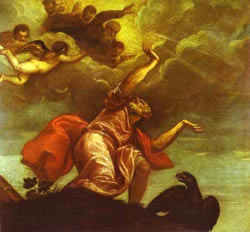2 John
 The Second Epistle of John, often referred to as Second John and often written 2 John or II John, is a book of the New Testament attributed to John the Evangelist, traditionally thought to be the author of the other two epistles of John, and the Gospel of John (though this is disputed). Most modern scholars believe this is not John the Apostle, but in general there is no consensus as to the identity of this person or group.
The Second Epistle of John, often referred to as Second John and often written 2 John or II John, is a book of the New Testament attributed to John the Evangelist, traditionally thought to be the author of the other two epistles of John, and the Gospel of John (though this is disputed). Most modern scholars believe this is not John the Apostle, but in general there is no consensus as to the identity of this person or group.
Second John and Third John are the two shortest books in the Bible. The shortest book in the English language is different depending on which translation (version) you look at. For example, in the New International Version 2 John is the shortest book with only 302 words but in the King James Version (Authorized Version) 3 John is the shortest with only 295 words. However, Second John has the fewest verses in the Bible with only 1 chapter made up of only 13 verses.
The language of this epistle is remarkably similar to 3 John. It is therefore suggested by a few that a single author composed both of these letters. The traditional view contends that all the letters are by the hand of John the Apostle, and the linguistic structure, special vocabulary, and polemical issues all lend toward this theory.
Also significant is the clear warning against paying heed to those who say that Jesus was not a flesh-and-blood figure: "For many deceivers are entered into the world, who confess not that Jesus Christ is come in the flesh." This establishes that, from the time the epistle was first written, there were those who had docetic Christologies, believing that the human person of Jesus was actually pure spirit or not come at all.
Alternatively, the letter's acknowledgment and rejection of gnostic theology may reveal a later date of authorship than orthodox Christianity claims. This can not be assured by a simple study of the context. Gnosticism's beginnings and its relationship to Christianity are poorly dated, due to an insufficient corpus of literature relating the first interactions between the two religions. It vehemently condemns such anti-corporeal attitudes, which also indicates that those taking such unorthodox positions were either sufficiently vocal, persuasive, or numerous enough to warrant rebuttal in this form. Adherents of gnosticism were most numerous during the second and third centuries.
Thus, in regard to this matter and this document, either one of two explanations is commonly held:
- Docetic and/or gnostic teachings were prevalent quite early in the history of Christianity, and these views were considered heretical and dangerous by the proto-orthodox Christian church.
- A late date of the composition (which often accompanies assertions of pseudepigraphal attribution).
View the Chapters of 2 John:
1